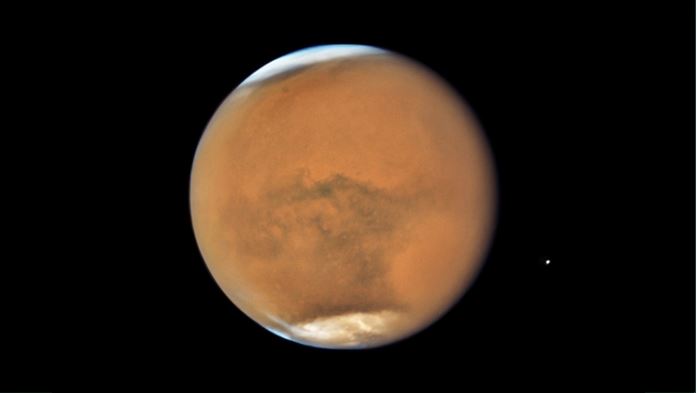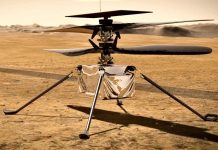
July 30 (UPI) — During the last two decades, Mars has captured the imagination of the public and attention of NASA decision makers, just as the moon excited the nation and served as the north star for the agency during the ’60s and ’70s.
Thursday morning’s planned launch of the Mars 2020 mission is the latest, and the most advanced step in exploring the Red Planet, built upon lessons from sending spacecraft to Mars at almost every launch opportunity since the 1990s.
Fascination with the planet, however, predates the first lunar landing or NASA’s Mars Exploration Program.
For as long as humans have been looking at the sky and writing stories, Mars has been mythologized. The Romans named the god of war after Mars, and the Red Planet found its way into Greek, Norse, Hindu and Chinese literature.
The 1897 novel “War of the Worlds” by H.G. Wells, which depicts an invasion of England by Martians, was adopted for radio in 1938 — a broadcast said to have caused panic among some listeners who didn’t know it was fictional.
The concept of “little green men” — often used generically to refer to aliens from any other planet, often as an invading force — overall started gaining popularity in the late 1800s, and grew exponentially from there.
Popular stories have ranged from Edgar Rice Burroughs’ “A Princess of Mars” in 1912 to the 1996 film “Mars Attacks,” which was adapted from a trading card series.
“Mars is a special place,” Casey Dreier, chief advocate and senior space policy adviser for the Planetary Society, told UPI. “It’s deeply embedded in our popular culture, going back hundreds, even thousands, of years — even before we knew anything about Mars.”
As more-capable telescopes arrived, Mars became more than just a red dot that grows larger every two years as its orbit comes closer to that of Earth’s.
“You begin to see features that look vaguely like Earth, you have polar caps and you have light and dark features that change over time, and that’s what I think inspired people to start imagining an Earth-like world with Earth-like things happening on the surface,” Bruce Betts, chief scientist at the Planetary Society, told UPI.
Exploring the Red Planet
As early as the 17th century, astronomers realized that Earth and Mars shared commonalities. But while humans imagined Mars as a kind of alien Earth for decades, it wasn’t until the early 2000s that scientists became certain of Mars’ Earth-like history.
It was the Mars Exploration Program that revealed the full extent of the Red Planet’s Earth-like qualities — that Mars did once have water, lots of it, and that Red Planet was once habitable.
“That’s all stuff we’ve learned relatively recently,” the Planetary Society’s Dreier said.
With each new mission to Mars, NASA’s landers, rovers and orbiters have made discoveries that raised new scientific questions, exciting researchers and titillating the public’s imagination.
And while the long history of human fascination has played an important role in fueling Martian exploration, both Betts and Dreier said NASA’s mission planning decisions have been driven largely by science and pragmatism.
Not only do Mars’ geologic wonders — a water world dried and frozen in time — offer a window into Earth’s primordial past, but they’re also closer than the interesting features found on any of Earth’s planetary neighbors.
Mars is hard to get to, but everywhere else besides the moon is even harder.
“(Because) Mars missions are so much faster than other planetary missions, it allows technology to develop and engineers to push those boundaries on much shorter time scales,” Dreier said.
The planning and execution of space missions to more distant targets can stretch a quarter of a century before scientists have their hands on fresh data.
Scientists working on the Mars 2020 mission will have to wait a little more than six months for the Perseverance rover to start returning usable data. That data — and the insights they provide planetary scientists — is likely to raise new questions about Mars. Rocks collected on this mission will not be brought back to Earth for a decade.
Beyond Mars missions
For now, NASA is working on plans for more scientific missions to Mars, and hopes to send humans to the Red Planet in the 2030s. But there is nothing concrete. A host of other plans for exploring the solar system exist, as well.
“As NASA’s planetary science budget has gone up, we’ve seen a huge burst of non-Mars missions happening,” Dreier said. “That’s a consequence of Mars getting a lot of attention for a lot of years, and the rest of the planetary science community making an effort to get greater support and more funds.”
NASA is working to once again ferry astronauts to and from the International Space Station, as well as finalizing plans for a human return to the moon.
The space agency also has several asteroid visitation missions in the pipeline, in addition to plans for a trip to Jupiter’s moon Europa and the outer reaches of the solar system. Under NASA’s Discovery program, tentative itineraries have been created for treks to Venus, Jupiter’s moon Io and Neptune’s moon Triton.
“There’s kind of a joke that a human Mars landing has been 20 years away for the last 60 years, but it’s not really a joke,” the Planetary Society’s Betts said.
“There is good science to be done all throughout the solar system, and there’s a limited amount of money and resources,” he said. “There is always division within the planetary science community about where you put your resources and where you send space missions.”






